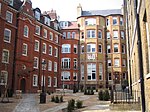The Honourable Society of the Inner Temple, commonly known as the Inner Temple, is one of the four Inns of Court and is a professional associations for barristers and judges. To be called to the Bar and practise as a barrister in England and Wales, a person must belong to one of these Inns. It is located in the wider Temple area, near the Royal Courts of Justice, and within the City of London.
The Inn is a professional body that provides legal training, selection, and regulation for members. It is ruled by a governing council called "Parliament", made up of the Masters of the Bench (or "Benchers"), and led by the Treasurer, who is elected to serve a one-year term. The Temple takes its name from the Knights Templar, who originally (until their abolition in 1312) leased the land to the Temple's inhabitants (Templars). The Inner Temple was a distinct society from at least 1388, although as with all the Inns of Court its precise date of founding is not known. After a disrupted early period (during which the Temple was almost entirely destroyed in the Peasants' Revolt) it flourished, becoming the second-largest Inn during the Elizabethan period (after Gray's Inn).
The Inner Temple expanded during the reigns of James I and Charles I, with 1,700 students admitted between 1600 and 1640. The First English Civil War's outbreak led to a complete suspension of legal education, with the Inns close to being shut down for almost four years. Following the English Restoration the Inner Templars welcomed Charles II back to London personally with a lavish banquet.
After a period of slow decline in the 18th century, the following 100 years saw a restoration of the Temple's fortunes, with buildings constructed or restored, such as the Hall and the Library. Much of this work was destroyed during The Blitz, when the Hall, Temple, Temple Church, and many sets of barristers' chambers were devastated. Rebuilding was completed in 1959, and today the Temple is a flourishing and active Inn of Court, with over 8,000 members.










